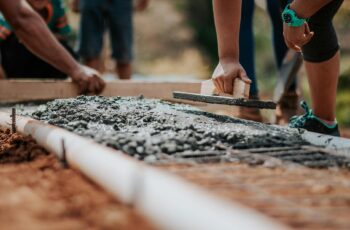Building a strong foundation is crucial for any structure, and the concrete footing is often the unsung hero. This fundamental element provides crucial support, transferring the weight of your building to the earth. Understanding its importance and the process involved is key to ensuring a stable and long-lasting building.
Types of Concrete Footings
There are several types of concrete footings, each suited to different soil conditions and building loads. Common types include spread footings, which distribute weight over a larger area, and pier footings, which are used in areas with unstable soil. The choice depends heavily on soil testing and engineering advice. Learn more about soil testing to determine the best option for your project.
Preparing the Site for Your Footing
Before pouring the concrete, thorough site preparation is essential. This includes excavating the area to the correct depth and dimensions, compacting the soil to prevent settling, and installing any necessary drainage systems. Careful measurement and accurate excavation are paramount. 
Formwork Construction
Formwork creates the shape for your concrete footing. This temporary structure must be strong enough to hold the wet concrete until it sets. Proper formwork construction ensures a clean, level footing, critical for even weight distribution. Discover suitable formwork materials for your project.
Reinforcement and Rebar
Steel reinforcement, commonly known as rebar, is embedded within the concrete to increase its tensile strength and prevent cracking. The amount and placement of rebar depend on the anticipated loads and local building codes. Incorrect placement can compromise structural integrity; thus, following a proper guide is highly recommended. [IMAGE_2_HERE]
Pouring the Concrete
The process of pouring the concrete requires attention to detail. It’s crucial to use the right mix design and ensure proper consolidation to eliminate air pockets. Vibration tools can help achieve a dense, strong footing. Using a concrete pump can make this process more efficient. [IMAGE_3_HERE]
Curing the Concrete
After pouring, the concrete must be cured properly to achieve its design strength. This involves keeping the concrete moist and at a consistent temperature for several days. Inadequate curing can lead to weakness and cracking. Learn more about proper concrete curing techniques.
Inspection and Backfilling
Once the concrete has cured, an inspection may be required to ensure it meets specifications. After a successful inspection, the area around the footing is backfilled with compacted soil, providing support and stability. This careful backfilling prevents settling and ensures the longevity of the footing. [IMAGE_4_HERE]
Conclusion
Constructing a durable concrete footing foundation is a fundamental step in any building project. By understanding the various stages, from site preparation to curing, you can ensure a stable and dependable base for your structure. Remember to consult with professionals and adhere to local building codes for optimal results. For more information, refer to resources from the American Concrete Institute and your local building department.
Frequently Asked Questions
What is the ideal depth for a concrete footing? The ideal depth depends on several factors, including soil type, climate, and building load. Consulting with a structural engineer is usually advisable for determining the proper depth.
How long does it take for concrete to cure? The curing time varies depending on factors such as temperature and humidity, but it typically takes several days to reach sufficient strength.
What type of concrete should I use for footings? The concrete mix design should meet specific strength requirements based on building codes and project needs. Consult with a concrete supplier for guidance.
Can I pour the footing myself, or do I need a contractor? While it’s possible to pour a footing yourself, especially for smaller projects, hiring a qualified contractor ensures the job is done correctly and to code.
What happens if my footing settles? Settling can cause various problems, from minor cracks to major structural damage. Early detection and appropriate repair work are necessary to prevent escalation.

